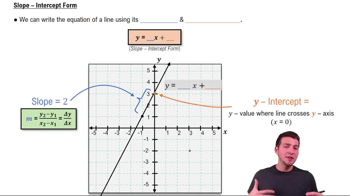Table of contents
- 0. Functions7h 52m
- Introduction to Functions16m
- Piecewise Functions10m
- Properties of Functions9m
- Common Functions1h 8m
- Transformations5m
- Combining Functions27m
- Exponent rules32m
- Exponential Functions28m
- Logarithmic Functions24m
- Properties of Logarithms34m
- Exponential & Logarithmic Equations35m
- Introduction to Trigonometric Functions38m
- Graphs of Trigonometric Functions44m
- Trigonometric Identities47m
- Inverse Trigonometric Functions48m
- 1. Limits and Continuity2h 2m
- 2. Intro to Derivatives1h 33m
- 3. Techniques of Differentiation3h 18m
- 4. Applications of Derivatives2h 38m
- 5. Graphical Applications of Derivatives6h 2m
- 6. Derivatives of Inverse, Exponential, & Logarithmic Functions2h 37m
- 7. Antiderivatives & Indefinite Integrals1h 26m
1. Limits and Continuity
Finding Limits Algebraically
Problem 23a
Textbook Question
Determine the following limits.
a. lim x→4^+ x − 5 / (x − 4)^2
 Verified step by step guidance
Verified step by step guidance1
Step 1: Identify the type of limit. This is a one-sided limit as \( x \) approaches 4 from the right (denoted by \( x \to 4^+ \)).
Step 2: Substitute \( x = 4 \) into the expression \( \frac{x - 5}{(x - 4)^2} \) to check for any indeterminate forms. This results in \( \frac{4 - 5}{(4 - 4)^2} = \frac{-1}{0} \), indicating a division by zero, which suggests a vertical asymptote.
Step 3: Analyze the behavior of the numerator and denominator as \( x \to 4^+ \). The numerator \( x - 5 \) approaches \( -1 \) as \( x \to 4^+ \). The denominator \( (x - 4)^2 \) approaches 0 from the positive side because squaring a small positive number results in a small positive number.
Step 4: Determine the sign of the limit. As \( x \to 4^+ \), \( x - 5 \) is negative and \( (x - 4)^2 \) is positive, so the overall expression \( \frac{x - 5}{(x - 4)^2} \) approaches negative infinity.
Step 5: Conclude that the limit is \(-\infty\) as \( x \to 4^+ \). This indicates that the function has a vertical asymptote at \( x = 4 \) and the function decreases without bound as \( x \) approaches 4 from the right.
Recommended similar problem, with video answer:
 Verified Solution
Verified SolutionThis video solution was recommended by our tutors as helpful for the problem above
Video duration:
1mPlay a video:
Was this helpful?
Key Concepts
Here are the essential concepts you must grasp in order to answer the question correctly.
Limits
A limit is a fundamental concept in calculus that describes the behavior of a function as its input approaches a certain value. It helps in understanding how functions behave near points of interest, including points of discontinuity or infinity. In this case, we are interested in the limit as x approaches 4 from the right (denoted as x→4^+).
Recommended video:

One-Sided Limits
One-Sided Limits
One-sided limits refer to the value that a function approaches as the input approaches a specific point from one side only. The notation x→4^+ indicates that we are considering values of x that are greater than 4. This is crucial for analyzing functions that may behave differently when approaching a point from the left versus the right.
Recommended video:

One-Sided Limits
Indeterminate Forms
Indeterminate forms occur in limit problems when direct substitution leads to expressions like 0/0 or ∞/∞, which do not provide clear information about the limit's value. In this question, substituting x=4 into the expression results in an indeterminate form, necessitating further analysis, such as factoring or applying L'Hôpital's Rule to resolve the limit.
Recommended video:
Guided course

Slope-Intercept Form

 5:21m
5:21mWatch next
Master Finding Limits by Direct Substitution with a bite sized video explanation from Callie
Start learningRelated Videos
Related Practice







